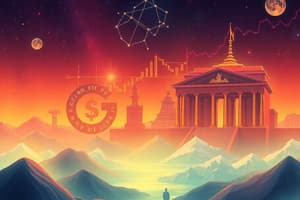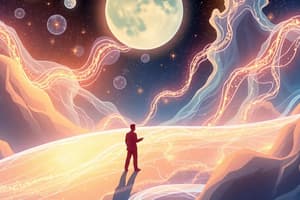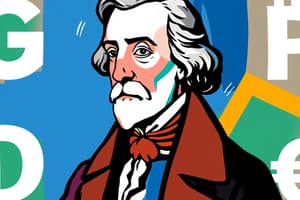Podcast
Questions and Answers
If nominal GDP increased by 5% and the GDP deflator increased by 2%, approximately what is the percentage change in real GDP?
If nominal GDP increased by 5% and the GDP deflator increased by 2%, approximately what is the percentage change in real GDP?
- 3% (correct)
- 7%
- 10%
- -3%
Which of the following scenarios would most likely result in cost-push inflation?
Which of the following scenarios would most likely result in cost-push inflation?
- A significant increase in the price of crude oil. (correct)
- Decreased interest rates leading to higher investment.
- Increased consumer spending due to higher consumer confidence.
- A large government infrastructure project.
Suppose the labor force is 150 million and the number of unemployed is 7.5 million. What is the unemployment rate?
Suppose the labor force is 150 million and the number of unemployed is 7.5 million. What is the unemployment rate?
- 15%
- 5% (correct)
- 7.5%
- 10%
During which phase of the business cycle is cyclical unemployment most likely to be the highest?
During which phase of the business cycle is cyclical unemployment most likely to be the highest?
Which of the following fiscal policies would be most effective in combating a recession?
Which of the following fiscal policies would be most effective in combating a recession?
Which monetary policy tool is most often used by a central bank to adjust the money supply?
Which monetary policy tool is most often used by a central bank to adjust the money supply?
If aggregate demand increases while aggregate supply remains constant, what is the likely effect on the price level and real GDP?
If aggregate demand increases while aggregate supply remains constant, what is the likely effect on the price level and real GDP?
Which of the following is the BEST example of investment, as defined in the expenditure approach to calculating GDP?
Which of the following is the BEST example of investment, as defined in the expenditure approach to calculating GDP?
Which type of unemployment is MOST likely to be caused by technological advancements that make certain job skills obsolete?
Which type of unemployment is MOST likely to be caused by technological advancements that make certain job skills obsolete?
Which of the following factors is LEAST likely to contribute to long-run economic growth?
Which of the following factors is LEAST likely to contribute to long-run economic growth?
Flashcards
Economics
Economics
The study of how societies allocate scarce resources to satisfy unlimited wants and needs.
Economic Growth
Economic Growth
A sustained increase in the production of goods and services in an economy.
Gross Domestic Product (GDP)
Gross Domestic Product (GDP)
The total market value of all final goods and services produced within a country’s borders during a specific time period.
Nominal GDP
Nominal GDP
Signup and view all the flashcards
Real GDP
Real GDP
Signup and view all the flashcards
Inflation
Inflation
Signup and view all the flashcards
Consumer Price Index (CPI)
Consumer Price Index (CPI)
Signup and view all the flashcards
Unemployment
Unemployment
Signup and view all the flashcards
Fiscal Policy
Fiscal Policy
Signup and view all the flashcards
Monetary Policy
Monetary Policy
Signup and view all the flashcards
Study Notes
- Economics studies how societies allocate scarce resources to fulfill unlimited wants and needs.
- Macroeconomics concentrates on the economy's overall performance, covering economic growth, inflation, unemployment, and government policies.
Key Macroeconomic Goals
- Economic growth is a sustained rise in the production of goods and services within an economy.
- Full employment signifies an economy operating at its potential output level, marked by low unemployment.
- Price stability involves maintaining a stable average price level to avoid high inflation or deflation.
Gross Domestic Product (GDP)
- GDP represents the total market value of all final goods and services produced within a country's borders during a specific period.
- It serves as a primary indicator of an economy's size and health.
GDP Calculation Methods
- Expenditure Approach: GDP = Consumption (C) + Investment (I) + Government Spending (G) + Net Exports (NX).
- Consumption includes household spending on goods and services.
- Investment covers business spending on capital goods, inventories, and residential construction.
- Government spending encompasses government expenditures on goods and services.
- Net exports are exports minus imports (NX = Exports - Imports).
- Income Approach: GDP equals the sum of all income earned: wages, rents, interest, and profits.
Nominal vs. Real GDP
- Nominal GDP is measured in current prices.
- Real GDP is adjusted for inflation, reflecting the actual quantity of goods and services produced.
- Real GDP offers a more accurate measure of economic growth by eliminating the effects of price changes.
GDP Deflator
- The GDP deflator measures the price level of all new, domestically produced, final goods and services.
- It is calculated as (Nominal GDP / Real GDP) * 100.
- It reflects changes in prices.
Inflation
- Inflation is a sustained increase in the general price level over time.
- It erodes purchasing power.
- It is typically measured using the Consumer Price Index (CPI) or the GDP deflator.
Consumer Price Index (CPI)
- The CPI measures the average change over time in prices paid by urban consumers for a basket of goods and services.
- It is utilized to track inflation and adjust wages, salaries, and government benefits.
Calculating Inflation Rate
- Inflation Rate = ((CPI in Current Year - CPI in Previous Year) / CPI in Previous Year) * 100.
- The inflation rate is the percentage change in the price level from one period to another.
Types of Inflation
- Demand-pull inflation occurs when aggregate demand exceeds aggregate supply, pulling prices upward.
- Cost-push inflation occurs when production costs increase, pushing prices upward.
- Built-in inflation occurs when wages and prices increase in response to past inflation.
Unemployment
- Unemployment is when individuals willing and able to work cannot find employment.
- It represents wasted resources and economic inefficiency.
Labor Force
- The labor force includes all employed individuals and those unemployed but actively seeking work.
- It excludes those not actively seeking work (e.g., students, retirees).
Unemployment Rate
- Unemployment Rate = (Number of Unemployed / Labor Force) * 100.
- It indicates the percentage of the labor force that is unemployed.
Types of Unemployment
- Frictional unemployment occurs when workers are temporarily between jobs or are new entrants to the labor force.
- Structural unemployment occurs when there is a mismatch between workers' skills and employers' demands.
- Cyclical unemployment occurs due to business cycle fluctuations, rising during recessions and falling during expansions.
- Seasonal unemployment occurs due to seasonal variations in employment (e.g., agricultural work).
Natural Rate of Unemployment
- The natural rate of unemployment is the sum of frictional and structural unemployment.
- It represents the unemployment rate when the economy operates at its potential output.
Business Cycles
- Business cycles are recurring fluctuations in economic activity, marked by periods of expansion and contraction.
- Expansion is a period of economic growth with increasing employment and output.
- Peak is the highest point of economic activity in a business cycle.
- Contraction is a period of economic decline with decreasing employment and output; also known as a recession.
- Trough is the lowest point of economic activity in a business cycle.
Fiscal Policy
- Fiscal policy uses government spending and taxation to influence the economy.
- It aims to stabilize the economy, promote economic growth, and reduce unemployment.
Fiscal Policy Tools
- Government spending directly impacts aggregate demand and can stimulate the economy during a recession.
- Taxation influences disposable income and can be used to curb inflation or stimulate spending.
Types of Fiscal Policy
- Expansionary fiscal policy involves increasing government spending or decreasing taxes to stimulate economic activity.
- Contractionary fiscal policy involves decreasing government spending or increasing taxes to cool down an overheated economy and reduce inflation.
Budget Deficit and National Debt
- A budget deficit occurs when government spending exceeds government revenue in a fiscal year.
- National debt is the accumulation of past budget deficits.
Monetary Policy
- Monetary policy involves actions by a central bank to manipulate the money supply and credit conditions.
- The primary goal is to maintain price stability and promote full employment.
Central Bank
- The central bank oversees the banking system and conducts monetary policy.
Monetary Policy Tools
- Open market operations involve buying and selling government securities to influence the money supply.
- Discount rate is the interest rate at which commercial banks can borrow money directly from the central bank.
- Reserve requirements are the fraction of deposits that banks must keep in reserve.
Types of Monetary Policy
- Expansionary monetary policy involves increasing the money supply and lowering interest rates to stimulate economic activity.
- Contractionary monetary policy involves decreasing the money supply and raising interest rates to cool down an overheated economy and reduce inflation.
Aggregate Supply and Demand
- The aggregate supply and demand model explains the relationship between the overall price level and production in an economy.
- Aggregate Demand (AD): The total demand for goods and services at a given price level.
- Aggregate Supply (AS): The total supply of goods and services at a given price level.
Factors Affecting Aggregate Demand
- Changes in consumer spending, investment spending, government spending, and net exports.
Factors Affecting Aggregate Supply
- Changes in input costs, technology, and resource availability.
Equilibrium in AS-AD Model
- Equilibrium occurs where aggregate demand intersects aggregate supply.
- The price level and output are determined at this intersection.
Economic Growth
- Economic growth is the increase in the production of goods and services over time.
- It is typically measured by the percentage change in real GDP.
Factors Contributing to Economic Growth
- Increase in Physical Capital: more machines, factories and infrastructure
- Increase in Human Capital: more skilled and educated workforce
- Technological Advancements: innovation and improvements in production processes.
- Natural Resources: The availability and efficient use of natural resources
Productivity
- Productivity is the amount of output produced per unit of input.
- Higher productivity leads to greater economic growth.
Long-Run Economic Growth
- Long-run economic growth depends on factors that increase the economy's potential output.
- Policies promoting investment in physical and human capital and encouraging technological innovation can foster long-run growth.
Studying That Suits You
Use AI to generate personalized quizzes and flashcards to suit your learning preferences.




